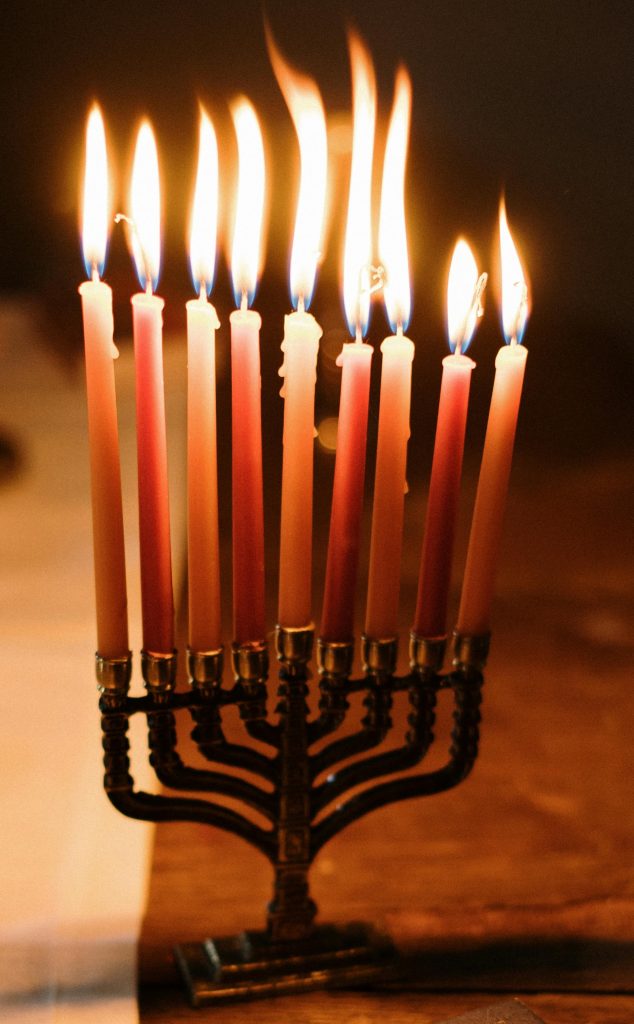6.1 Die Vorweihnachtszeit

Theodor Fontane, “Verse zum Advent” |
Lektionsüberblick
On December 1, the Adventszeit begins in German-speaking Europe with the traditional Adventskalender. People of all ages enjoy opening a little door every day to find a piece of chocolate or other treat inside. In this lesson, we will learn about some Christmas traditions in the weeks leading up to Heiligabend. We will also learn about Chanukka/Lichterfest. In the end, you will be able to recognize some of these 1) private Christmas traditions, 2) Chanukka traditions, 2) public Christmas traditions and 4) compare them with your own holiday traditions.
Hier ist ein Kalender mit vielen der Advents- und Weihnachtsbräuchen aus den deutschsprachigen Ländern.

1) Die Adventszeit zu Hause
We will first learn about some of the most common Advent traditions from German-speaking countries found in the home including some typical kinds of decorations.
Let’s check your comprehension!
Jetzt bist du dran!
Welche von den Adventsbräuchen kennst du von zu Hause? Welche möchtest du jetzt beginnen? Answer the questions in your written journal. Then record yourself in your audio journal.
2) Chanukka – das Lichterfest
Listen to and read along with the follow text about Chanukka.


In der Schweiz leben etwa 18.000 Juden (in Deutschland sind es circa 200.000, in Österreich circa 15.000, und in Liechtenstein circa 30). Ein sehr wichtiges Fest in der jüdischen Religion ist Chanukka (Lichterfest). Es wird jedes Jahr im Winter (November oder Dezember) gefeiert. Vor mehr als 2000 Jahren hatten griechische Herrscher (=ruler) das Volk Israel unterdrückt (=suppress) und ihre Tempel weggenommen, um ihre eigenen Götter (z.B. Zeus) dort anzubeten (=worship). Die Juden haben gegen die Griechen gekämpft und haben schließlich ihren Tempel zurückerobert (=reclaim). Im Tempel hat es aber nicht mehr genug Öl für die Menora gegeben (ein siebenarmiger Leuchter (=candlestick), der immer brennen muss). Durch ein Wunder hat der Leuchter dann aber acht Tage lang gebrannt (=burned) und deshalb dauert das Chanukka-Fest auch acht Tage.


Zur Erinnerung an dieses Wunder wird an jedem Tag eine weitere Kerze am Chanukkia, dem neunarmigen Leuchter, angezündet. Am Abend feiern Familie und Freunde dieses Fest zusammen. Man isst jüdische Spezialitäten, die in Öl gebacken sind wie zum Beispiel Latkes (Kartoffelpuffer) oder Sufganiyot (Kreppel), singt Lieder und spielt Spiele zusammen. Die Kinder bekommen Geschenke und Geld.
Let’s check your comprehension!
Here’s a short video Was ist Chanukka?
Jetzt bist du dran!
Feierst du Chanukka? Wenn ja, welche Traditionen hast du? Wenn nicht, was weißt du darüber, wie Chanukka in den USA gefeiert wird? Answer the questions in your written journal. Then record your answer.
3) Adventsaktivitäten
Now we will learn about some of the most common Advent traditions that take place in the community.
Let’s check your comprehension!
Jetzt bist du dran!
Welche von den Adventsbräuchen kennst du von deiner Heimatstadt? Welche möchtest du kennenlernen? Answer the questions in your written journal. Then record yourself in your audio journal.
Deutsch IRL (and some English)
- Alle Jahre wieder: Der Weihnachtsmarkt (5m)
- Weihnachtsmarkt (18m), Podcast: Inge möchte sehr gerne zum Weihnachtsmarkt gehen, aber ihr Freund ist nicht so begeistert
- Weihnachtsmarkt in Deutschland: gemütlich, bunt, traditionell
- Morgen kommt der Nikolaus, short reading
- The Many German St. Nicks
4) Adventszeit in den USA
Many of our US Christmas traditions come from German-speaking countries, often with a change. Think about Nikolaustag: Instead of putting cleaned shoes in front of your door on December 5th for St. Nick to fill, you may hang up a stocking on your fireplace on December 24. The Christmas tree tradition (der Weihnachtsbaum) comes from German-speakers as well, but we have also changed the timing of that tradition! Most households celebrating Christmas in German-speaking Europe will not put up and decorate their tree until Heiligabend (Christmas Eve), while some people in the US put it up right after Halloween!
Look at these other US Christmas traditions.
Jetzt bist du dran!
Welche Weihnachtstraditionen kennst du aus deiner Kindheit? Welche machst du immer noch? Answer the questions in your written journal using the modeled language above. Check your writing and then record your answer.
Jetzt kombinieren
In this lesson, you learned how to be able to recognize some 1) private Christmas traditions, 2) Chanukka traditions, 2) public Christmas traditions and 4) compare them with your own holiday traditions. Now let’s combine what you’ve learned!
Imagine you are on a study abroad in a German-speaking country and you start talking to a new friend about Advent traditions. What do you tell your friend about how you typically spend the weeks leading up to Christmas day? How does your friend response? In your written journal, write up a dialogue between you and your friend, using the modeled language and content from this lesson. Check your work and then record your conversation in your audio journal.
As always: feel free to meet up with a classmate and record together!

Media Attributions
- Chanukka text adapted from adapted from Willkommen: Deutsch für alle 2, Copyright © 2020 by Claudia Kost and Crystal Sawatzky, licensed under the CC BY-NC-SA International License 4.0.
Media Attributions
- 2030-2040 ch banner reduced size
- fontanes gedicht
- kalender-dezember-2024
- 6.1 menorah-318641_1280
- 6.1 chanukkia pexels-cottonbro-4038293
- 6.1 chanukka potato-pancakes-544712_1280
- 6.1 chanukka kreppel donut-6840578_1280

